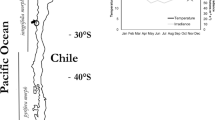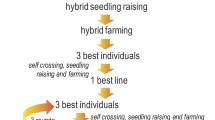Abstract
When cultivating the kelp, Saccharina japonica, in China, one of the causes leading to degeneration in blade quality and productivity has been thought to be inbreeding caused by the use of limited numbers of sorus-bearing individuals that are continuously used over generations to produce large numbers of offspring. One of the effective solutions is to use intraspecific hybrid vigor to produce new cultivars or to recreate the original agronomic features of the older cultivars. This study produced a sporophytic B013 (cultivar code) by crossing a pair of distantly related unialgal male and female gametophyte clones. The male was isolated from an individual collected from a farmed population at Rongcheng, China, while the female came from a Korean wild individual sporophyte. In comparison with four controls, the B013 sporophytic offspring demonstrated excellent blade quality (entirely dark green in the dried product), high alginate (29.7–32.9 %) and iodine (0.29–0.31 mg g−1) contents in the dried product, the lowest fresh weight/sun-dried weight (FW/DW) ratio and the smallest coefficients of variation for total length (7.4 %), width (6.9 %), and biomass output (14.6 %). In addition, this cultivar remained in a vegetative state from June to August, greatly reducing the biomass loss during the hot summer season. In comparison with seeding zoospores for seedling production, seeding a selected pair of unialgal gametophytes had apparent advantages in effectively preventing inbreeding depression, which gave rise to a uniformed product and provided new cultivars for large-scale farming.


Similar content being viewed by others
References
Fang JG, Sun HL, Kuang SH, Sun Y, Zhou SL, Song YL, Cui Y, Zhao J, Yang QF, Li F (1996) Assessing the carrying capacity of Sanggou Bay for culture of kelp Laminaria japonica. Mar Fish Res 17:7–17
Keller LF, Waller DM (2002) Inbreeding effects in wild populations. Trends Ecol Evol 17:230–241
Kim HG, Park JG, Kim DS (2005) Comparative laboratory culture studies of the native kelp, Kjellmaniella crassifolia and the introduced kelp Laminaria japonica in east coast of Korea. J Aquac 18:299–304 (In Korean with English abstract)
Li XJ, Cong YZ, Yang GP, Shi YY, Qu SC, Li ZL, Wang GW, Zhang ZZ, Luo SJ, Dai HL, Xie JZ, Jiang GL, Liu JL, Wang TY (2007) Trait evaluation and trial cultivation of Dongfang No. 2, the hybrid of a male gametophyte clone of Laminaria longissima (Laminariales, Phaeophyta) and a female one of L. japonica. J Appl Phycol 19:139–151
Li XJ, Liu JL, Cong YZ, Qu SC, Zhang ZZ, Dai HL, Luo SJ, Han XB, Huang SS, Wang QY, Liang GJ, Sun J, Jin Y, Wang DQ, Yang GP (2008) Breeding and trial cultivation of Dongfang No. 3, a hybrid of Laminaria gametophyte clones with a more than intraspecific but less than interspecific relationship. Aquaculture 280:76–80
Li J, Pang SJ, Liu F, Shan TF, Gao SQ (2013) Spermatozoid life-span of two brown seaweeds, Saccharina Japonica and Undaria pinnatifida, as measured by fertilization efficiency. Chin J Oceanol Limnol 31:774–781
Pang SJ, Hu XY, Wu CY, Hirosawa A, Ohno M (1997) Intraspecific crossings of Undaria pinnatifida (Harv.) Sur.—a possible time-saving way of strain selection. Chin J Oceanol Limnol 15:227–235
Perèz R, Kaas R, Campelle F, Arbault S, Barbaroux O (1992) La culture de l’algue Undaria pinnatifida (Harvey) Suringar. In: Perèz R (ed.), La Culture des Algues Marines dans le Monde. Service de la Documentation et des Publications (SDP), INFREMER, pp. 425–462
Robinson N, Winberg P, Kirkendale L (2013) Genetic improvement of macroalgae: status to date and needs for the future. J Appl Phycol 25:703–716
Saccheri I, Kuussaari M, Kankare M, Vikman P, Fortelius W, Hanski I (1998) Inbreeding and extinction in a butterfly population. Nature 392:491–494
Shan TF, Pang SJ (2009) Assessing genetic identity of sporophytic offspring of the brown alga Undaria pinnatifida derived from mono-crossing of gametophyte clones by use of amplified fragment length polymorphism and microsatellite markers. Phycol Res 57:36–44
Shan TF, Liu F, Liu QS, Pang SJ (2011) Review and prospect of “summer sporeling” technique of Saccharina japonica in China. J Agri Sci Technol 13:129–134
Shang DR, Ning JS, Zhao YF, Zhai YX, Shu BS, Sheng XF, Guo YY (2011) Establishment of the determination on kelp alginate. Food Sci Technol 36(8):252–254 (In Chinese with English abstract)
Starr R, Zeikus JA (1987) UTEX—the culture collection of algae at the University of Texas at Austin. J Appl Phycol 23:1–47
Tseng CK (2001) Algal biotechnology industries and research activities in China. J Appl Phycol 13:375–380
Xu B, Zhang QS, Qu SC, Cong YZ, Tang XX (2009) Introduction of a seedling production method using vegetative gametophytes to the commercial farming of Laminaria in China. J Appl Phycol 21:171–178
Zhang QS, Tang XX, Cong YZ, Qu SC, Luo SJ, Yang GP (2007) Breeding of an elite Laminaria variety 90-1 through inter-specific gametophyte crossing. J Appl Phycol 19:303–311
Zhang QS, Qu SC, Luo SJ, Tang XX (2008) High throughput culture and gametogenesis induction of Laminaria japonica gametophyte clones. J Appl Phycol 20:205–211
Zhang JH, Fang JG, Wang W, Du M, Gao YP, Zhang ML (2012) Growth and loss of mariculture kelp Saccharina japonica in Sungo Bay, China. J Appl Phycol 24:1209–1216
Zhao JY, Qin BC (2007) Determination on the iodine content of kelp. J Anyang Norm Univ 80(5):117–118 (In Chinese with English abstract)
Acknowledgments
The authors wish to thank Liu Qishun, Sun Changbin, Jiang Xige, Wang Jian, and Wang Jiaqi for their assistance with the algal farming. This research is supported by two projects of the National Natural Science Foundation of China (No. 41176135, 41206146), two projects on kelp breeding from the Chinese Academy of Sciences.
Author information
Authors and Affiliations
Corresponding author
Rights and permissions
About this article
Cite this article
Zhao, X.B., Pang, S.J., Liu, F. et al. Intraspecific crossing of Saccharina japonica using distantly related unialgal gametophytes benefits kelp farming by improving blade quality and productivity at Sanggou Bay, China. J Appl Phycol 28, 449–455 (2016). https://doi.org/10.1007/s10811-015-0597-2
Received:
Revised:
Accepted:
Published:
Issue Date:
DOI: https://doi.org/10.1007/s10811-015-0597-2




